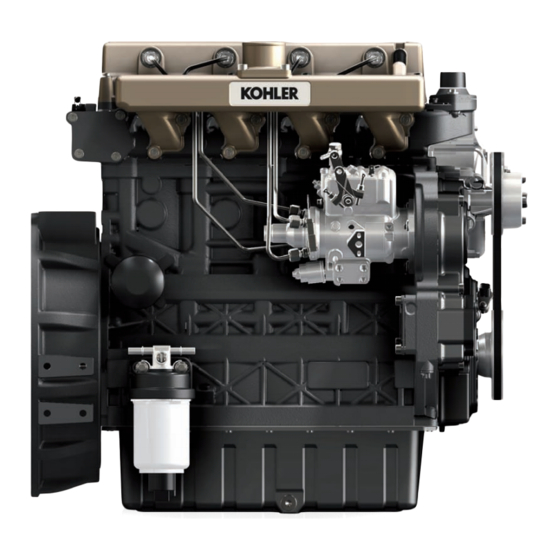Kohler KDI 1903M Руководство пользователя - Страница 13
Просмотреть онлайн или скачать pdf Руководство пользователя для Портативный генератор Kohler KDI 1903M. Kohler KDI 1903M 40 страниц. Diesel kdi
Также для Kohler KDI 1903M: Руководство пользователя (38 страниц), Руководство пользователя (50 страниц), Использование и обслуживание (42 страниц)

2.5.1
Fuel for low temperatures
• When operating the engine in ambient temperatures lower than 0 degrees C, use suitable low temperature fuel normally
available from fuel distributors and corresponding to the specifications of
• These fuels reduce the formation of paraffin in diesel at low temperatures.
• When paraffin forms in the diesel, the fuel filter becomes blocked interrupting the flow of fuel.
2.5.2
Biodiesel fuel
• Fuels containing 10% methyl ester or B10, are suitable for use in this engine provided that they meet the specifications listed
in the Tab. 2.3.
• DO NOT USE vegetable oil as a biofuel for this engine.
2.4
US biodiesel according to ASTM D6751 – 09a (B100) (only permissible for mixtures with diesel fuel at 10% (V/V))
2.5.3
Synthetic fuels: GTL, CTL, BTL, HV
It is a well-known fact that engines which are operated for longer periods with conventional diesel fuel and then converted
to synthetic fuels suffer shrinkage of polymer seals in the injection system and thus fuel leaks. The reason for this behavior is
that the aromatic-free synthetic fuels can lead to a change in the selling behavior of polymer seals.
Therefore, conversion from diesel fuel to synthetic fuel may only be done after changing the critical seals. The problem of
shrinkage does not occur when an engine was operated with synthetic fuel from the start.
2.5.4
Non-Road Fuels
Other non-road fuels may be used if they comply with all the limit values of EN 590 except for the fuel density, the cetane
number and the sulfur content.
The following limits apply for these parameters:
2.5
2.5.5
Jet Fuels
Only for KDI Mechanical Injection Uncertified Engines (no EGR Engines).
The following jet fuels can be used but only adopting an additional fuel filter with lubricity doser:
2.6
F-34/F-35 (kerosene, NATO designation)
F-63 (kerosene, NATO designation, equivalent to
F-65 (kerosene, NATO designation, 1:1 mixture of F-54
2.5.6
Emission-Related Installation Instructions
Failing to follow the instructions in the applications guidebook when installing a certified engine in a piece of nonroad equipment
violates federal law (40 CFR 1068.105(b)), subject to fines or other penalties as described in the Clean Air Act.
OEM must apply a separate label with the following statement: "ULTRA LOW SULFUR FUEL ONLY" near the fuel inlet.
Ensure you are installing an engine appropriately certified for your application. Constant speed engines may only be installed
on constant speed equipment for constant speed operation.
If you install the engine in a way that makes the engine's emission control information label hard to read during normal engine
maintenance, you must place a duplicate label on the equipment, as described in 40 CFR 1068.105.
ED0053029510
_14.1
Index
Biodiesel according to EN 14214 (only permissible for mixture with diesel fuel at max. 10% (V/V))
FUEL PARAMETER
Cetane number
Fuel density at 15°C
Sulfur content
F-44 (kerosene, NATO designation
F-34/F-35 with additives)
and F-34/F-35)
TECHNICAL INFORMATION
BIODIESEL COMPATIBILITY
UNIT
Kg/m3
mg/kg or ppm
FUEL
Tab.
2.3.
LIMIT VALUE
Min. 49
820 - 860
max. 500
JP-8 (kerosene, US military designation)
JP-5 (kerosene, US military designation)
Jet A (kerosene for civil aviation)
Jet A1 (kerosene for civil aviation)
2
EN
13
